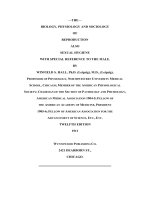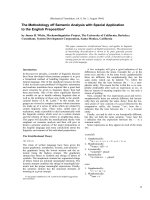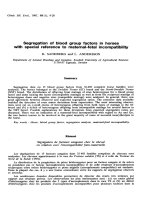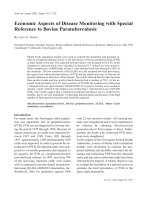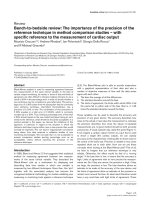HYGIENIC PHYSIOLOGY WITH SPECIAL REFERENCE TO THE USE OF ALCOHOLIC DRINKS AND NARCOTICS BEING A REVISED EDITION OF THE FOURTEEN WEEKS IN HUMAN PHYSIOLOGY ppt
Bạn đang xem bản rút gọn của tài liệu. Xem và tải ngay bản đầy đủ của tài liệu tại đây (1.18 MB, 532 trang )
HYGIENIC PHYSIOLOGY
WITH SPECIAL REFERENCE TO THE USE OF
ALCOHOLIC DRINKS AND NARCOTICS
BEING A REVISED EDITION OF THE
FOURTEEN WEEKS IN HUMAN PHYSIOLOGY
BY JOEL DORMAN STEELE, PH.D.
ENLARGED EDITION WITH SELECTED
READINGS
_Edited for the use of Schools, in accordance with the recent
Legislation upon Temperance Instruction_
INDORSEMENT.
BOSTON, _June_ 20, 1889.
The Pathfinder Series of Text-books on Anatomy, Physiology, and Hygiene
consists of the following volumes:
I. Child's Health Primer (for Primary Grades).
II. Hygiene for Young People or, Young People's Physiology. (for
Intermediate Classes)
III. Hygienic Physiology (for Advanced Pupils).
The above are the series originally prepared (as their general title
indicates) to supply the demand created by the laws for temperance
instruction in public schools in the United States. They were written by
experts under the supervision of the Scientific Department of the National
Woman's Christian Temperance Union, published by the instigation of the
same, and have been carefully revised from time to time, under the same
supervision, to keep them abreast with the latest teachings of science.
Being both teachable and well adapted to grade, their educational value,
as proven by schoolroom tests, is of the highest order. We therefore
cordially indorse and highly recommend the Pathfinder Series for use in
schools.
MARY H. HUNT,
_National and International Superintendent of the Scientific Dep't of
the Woman's Christian Temperance Union; Life Director of the National
Educational Association._
ADVISORY BOARD:
JOSEPH COOK, WILLIAM E. SHELDON, ALBERT H. PLUMB, D.D., DANIEL
DORCHESTER,
D.D.
PREFACE
The term Physiology, or the science of the functions of the body, has come
to include Anatomy, or the science of its structure, and Hygiene, or the
laws of health; the one being essential to the proper understanding of
physiology, and the other being its practical application to life. The
three are intimately blended, and in treating of the different subjects
the author has drawn no line of distinction where nature has made none.
This work is not prepared for the use of medical students, but for the
instruction of youth in the principles which underlie the preservation of
health and the formation of correct physical habits. All else is made
subservient to this practical knowledge. A simple scientific dress is used
which, while conducing to clearness, also gratifies that general desire of
children to know something of the nomenclature of any study they pursue.
To the description of each organ is appended an account of its most common
diseases, accidents, etc., and, when practicable, their mode of treatment.
A pupil may thus learn, for example, the cause and cure of "a cold," the
management of a wound, or the nature of an inflammation.
The Practical Questions, which have been a prominent feature in other
books of the series, will be found, it is hoped, equally useful in this
work. Directions for preparing simple microscopic objects, and
illustrations of the different organs, are given under each subject.
The Readings, which represent the ideas but not always the exact
phraseology of the author quoted, have, in general, been selected with
direct reference to Practical Hygiene, a subject which now largely
occupies the public mind. The dangers that lurk in foul air and
contaminated water, in bad drainage, leaky gas pipes, and defective
plumbing, in reckless appetites, and in careless dissemination of
contagious diseases, are here portrayed in such a manner as, it is
trusted, will assist the pupil to avoid these treacherous quicksands, and
to provide for himself a solid path of health.
Under the heading of Health and Disease will be found Hints about the sick
room, Directions for the use of Disinfectants, Suggestions as to what to
do "Till the Doctor comes," and a list of antidotes for Poisons. Questions
for Class Use, a full Glossary, and an ample Index complete the book.
Believing in a Divine Architect of the human form, the author can not
refrain from occasionally pointing out His inimitable workmanship, and
impressing the lesson of a Great Final Cause.
The author has gleaned from every field, at home and abroad, to secure
that which would interest and profit his pupils. In general, Flint's great
work on the "Physiology of Man," an undisputed authority on both sides of
the Atlantic, has been adopted as the standard in digestion, respiration,
circulation, and the nervous system. Leidy's "Human Anatomy," and Sappey's
"Traité d'Anatomie" have been followed on all anatomical questions, and
have furnished many beautiful drawings. Huxley's "Physiology" has afforded
exceedingly valuable aid. Foster's "Text-Book of Physiology," Hinton's
"Health and its Conditions," Black's "Ten Laws of Health," Williams's
practical essay on "Our Eyes and How to Use them," Le Pileur's charming
treatise on "The Wonders of the Human Body," and that quaint volume, "Odd
Hours of a Physician," have aided the author with facts and fancies. The
writings of Draper, Dalton, Carpenter, Yalentin, Mapother, Watson,
Lankester, Letheby, Hall, Hamilton, Bell, Wilson, Bower, Cutter,
Hutchison, Wood, Bigelow, Stille, Holmes, Beigel, and others have been
freely consulted.
PUBLISHERS' NOTE.
An ABRIDGED EDITION of this work is published, to afford a cheaper manual
adapted to Junior Classes and Common Schools. The abridgment contains
the essence of this text, nearly all its illustrations, and the whole of
the Temperance matter as here presented.
ORDER "HYGIENIC PHYSIOLOGY, ABRIDGED."
READING REFERENCES.
Foster's "Text-Book of Physiology"; Leidy's "Human Anatomy"; Draper's
"Human Physiology"; Dalton's "Physiology and Hygiene"; Cutter's
"Physiology"; Johnston and Church's "Chemistry of Common Life"; Letheby's
"Food"; Tyndall "On Light," and "On Sound"; Mint's "Physiology of Man ";
Rosenthal's "Physiology of the Muscles and Nerves"; Bernstein's "Five
Senses of Man"; Huxley and Youmans's "Physiology and Hygiene"; Sappey's
"Traité d'Anatomie "; Luys's "Brain and its Functions"; Smith's "Foods";
Bain's "Mind and Body"; Pettigrew's "Animal Locomotion"; Carpenter's
"Human Physiology," and "Mental Physiology"; Wilder and Gage's "Anatomy";
Jarvis's "Physiology and Laws of Health."
Hargreaves's "Alcohol and Science"; Richardson's "Ten Lectures on
Alcohol," and "Diseases of Modern Life"; Brown's "Alcohol"; Davis's
"Intemperance and Crime"; Pitman's "Alcohol and the State"; "Anti-
Tobacco"; Howie's "Stimulants and Narcotics"; Hunt's "Alcohol as Food or
Medicine"; Schützenberger's "Fermentation"; Hubbard's "Opium Habit and
Alcoholism"; Trouessart's "Microbes, Ferments, and Molds."
CONTENTS
INTRODUCTION
I THE SKELETON
THE HEAD
THE TRUNK
THE LIMBS
II THE MUSCLES
III THE SKIN
THE HAIR AND THE NAILS
THE TEETH
IV RESPIRATION AND THE VOICE
V THE CIRCULATION
THE BLOOD
THE HEART
THE ARTERIES
THE VEINS
VI DIGESTION AND FOOD
VII THE NERVOUS SYSTEM
THE BRAIN
THE SPINAL CORD AND THE NERVES
THE SYMPATHETIC SYSTEM
VIII THE SPECIAL SENSES
TOUCH
TASTE
SMELL
HEARING
SIGHT
IX HEALTH AND DISEASE DEATH AND DECAY
1. HINTS ABOUT THE SICK ROOM
2. DISINFECTANTS
3. WHAT TO DO "TILL THE DOCTOR COMES"
4. ANTIDOTES TO POISONS
X SELECTED READINGS
XI APPENDIX
QUESTIONS FOR CLASS USE
GLOSSARY
INDEX
SUGGESTIONS To Teachers
Seeing is believing more than that, it is often knowing and remembering.
The mere reading of a statement is of little value compared with the
observation of a fact. Every opportunity should therefore be taken of
exhibiting to the pupil the phenomena described, and thus making them
real. A microscope is so essential to the understanding of many subjects,
that it is indispensable to the proper teaching of Physiology. A suitable
instrument and carefully prepared specimens, showing the structure of the
bones, the skin, and the blood of various animals, the pigment cells of
the eye, etc., may be obtained at a small cost from any good optician.
On naming the subject of a paragraph, the pupil should be prepared to tell
all he knows about it. No failure should discourage the teacher in
establishing this mode of study and recitation. A little practice will
produce the most satisfactory results. The unexpected question and the apt
reply develop a certain sharpness and readiness which are worthy of
cultivation. The questions for review, or any others that the wit of the
teacher may suggest, can be effectively used to break the monotony of a
topical recitation, thereby securing the benefits of both systems.
The pupil should expect to be questioned each day upon any subject passed
over during the term, and thus the entire knowledge gained will be within
his grasp for instant use. While some are reciting to the teacher, let
others write on slates or on the blackboard. At the close of the
recitation, let all criticise the ideas, the spelling, the use of
capitals, the pronunciation, the grammar, and the mode of expression.
Greater accuracy and much collateral drill may thus be secured at little
expense of valuable school time.
The Introduction is designed merely to furnish suggestive material for the
first lesson, preparatory to beginning the study. Other subjects for
consideration may be found in the section on Health and Disease, in the
Selected Readings, and among the questions given in the Appendix. Where
time will allow, the Selected Readings may profitably be used in
connection with the topics to which they relate. Questions upon them are
so incorporated with those upon the text proper that they may be employed
or not, according to the judgment of the teacher.
NOTE Interest in the study of Physiology will be much increased by the
use of the microscope and prepared slides. These may be obtained from any
good optician.
INTRODUCTION.
Physiological study in youth is of inestimable value. Precious lives are
frequently lost through ignorance. Thousands squander in early years the
strength which should have been kept for the work of real life. Habits are
often formed in youth which entail weakness and poverty upon manhood, and
are a cause of lifelong regret. The use of a strained limb may permanently
damage it. Some silly feat of strength may produce an irreparable injury.
A thoughtless hour of reading by twilight may impair the sight for life. A
terrible accident may happen, and a dear friend perish before our eyes,
while we stand by powerless to render the assistance we could so easily
give did we "only know what to do." The thousand little hints which may
save or lengthen life, may repel or abate disease, and the simple laws
which regulate our bodily vigor, should be so familiar that we may be
quick to apply them in an emergency. The preservation of health is easier
than the cure of disease. Childhood can not afford to wait for the lesson
of experience which is learned only when the penalty of violated law has
been already incurred, and health irrevocably lost.
NATURE'S LAWS INVIOLABLE In infancy, we learn how terribly Nature
punishes a violation of certain laws, and how promptly she applies the
penalty. We soon find out the peril of fire, falls, edged tools, and the
like. We fail, however, to notice the equally sharp and certain
punishments which bad habits entail. We are quick to feel the need of
food, but not so ready to perceive the danger of an excess. A lack of air
drives us at once to secure a supply; foul air is as fatal, but it gives
us no warning.
Nature provides a little training for us at the outset of life, but leaves
the most for us to learn by bitter experience. So in youth we throw away
our strength as if it were a burden of which we desire to be rid. We eat
anything, and at any time; do anything we please, and sit up any number of
nights with little or no sleep. Because we feel only a momentary
discomfort from these physical sins, we fondly imagine when that is gone
we are all right again. Our drafts upon our constitution are promptly
paid, and we expect this will always be the case; but some day they will
come back to us, protested; Nature will refuse to meet our demands, and we
shall find ourselves physical bankrupts.
We are furnished in the beginning with a certain vital force upon which we
may draw. We can be spendthrifts and waste it in youth, or be wise and so
husband it till manhood. Our shortcomings are all charged against this
stock. Nature's memory never fails; she keeps her account with perfect
exactness. Every physical sin subtracts from the sum and strength of our
years. We may cure a disease, but it never leaves us as it found us. We
may heal a wound, but the scar still shows. We reap as we sow, and we may
either gather in the thorns, one by one, to torment and destroy, or we may
rejoice in the happy harvest of a hale old age.
I.
THE SKELETON.
"Not in the World of Light alone,
Where God has built His blazing throne,
Nor yet alone on earth below,
With belted seas that come and go,
And endless isles of sunlit green
Is all thy Maker's glory seen
Look in upon thy wondrous frame,
Eternal wisdom still the same!"
HOLMES.
ANALYSIS OF THE SKELETON.
NOTE The following Table of 206 bones is exclusive of the 8 sesamoid
bones which occur in pairs at the roots of the thumb and great toe, making
214 as given by Leidy and Draper. Gray omits the bones of the ear, and
names 200 as the total number.
THE SKELETON.
_
| I. THE HEAD (_28 bones._)
| _
| | Frontal Bone (forehead).
| _ | Two Parietal Bones.
| | 1. CRANIUM | Two Temporal (temple) Bones.
| | (_8 bones._) | Sphenoid Bone.
| | | Ethmoid (sieve-like bone at root of nose).
| | |_Occipital Bone (back and base of skull).
| | _
| | | Two Superior Maxillary (upper jaw) Bones.
| | | Inferior Maxillary (lower jaw) Bone.
| | | Two Malar (cheek) Bones.
| | 2. FACE | Two Lachrymal Bones.
| | (_14 bones._) | Two Turbinated (scroll like) Bones, each
| | | side of nose.
| | | Two Nasal Bones (Bridge of nose).
| | | Vomer (the bone between the nostrils).
| | |_Two Palate Bones.
| | _
| | | Hammer.
| | 3. EARS | Anvil.
| |_ (_6 bones._) |_Stirrup.
|
| II. THE TRUNK (_54 bones._)
| _
| | Cervical Vertebræ (seven vertebræ of the
| _ | neck).
| | 1. SPINAL COLUMN | Dorsal Vertebræ (twelve vertebræ of the
| | | back).
| | | Lumbar Vertebræ (five vertebræ of the
| | |_ loins).
| | _
| | | True Ribs.
| | 2. RIBS |_False Ribs.
| |
| | 3. STERNUM (breastbone).
| |
| | 4. OS HYOIDES (bone at the root of tongue).
| | _
| | | Two Innominata.
| |_5. PELVIS | Sacrum.
| |_Coccyx.
|
| III. THE LIMBS (_124 bones._)
| _
| _ | _Clavicle._
| | Shoulder |__Scapula._
| _ | _
| | 1. UPPER LIMBS | | _Humerus._
| | (_64 bones._) | Arm |__Ulna and Radius._
| | | _
| | | | _Eight Wrist or Carpal
| | | | Bones._
| | |_Hand | _Five Metacarpal Bones._
| | |__Phalanges (14 bones)._
| | _
| | _ | _Femur._
| | | Leg | _Patella._
| | | |__Tibia and Fibula._
| | 2. LOWER LIMBS | _
| |_ (_60 bones._) | | _Seven Tarsal Bones._
|_ | Foot | _Five Metatarsal Bones._
|_ |__Phalanges (14 bones)._
_
| 1. Uses.
_ | 2. Composition.
| 1. FORM, STRUCTURE, | 3. Structure.
| ETC., OF THE BONES | 4. Growth.
| | 5. Repair.
THE SKELETON | |_6. The Joints.
| _
| 2. CLASSIFICATION OF | 1. The Head.
|_ THE BONES. | 2. The Trunk.
|_3. The Limbs.
THE SKELETON.
I. FORM, STRUCTURE, ETC., OF THE BONES.
(_See page 269_.)
THE SKELETON, or framework of the "House we live in," is composed of about
200 bones. [Footnote: The precise number varies in different periods of
life. Several which are separated in youth become united in old age. Thus
five of the "false vertebræ" at the base of the spine early join in one
great bone the sacrum; while four tiny ones below it often run into a
bony mass the coccyx (Fig. 6); in the child, the sternum is composed of
eight pieces, while in the adult it consists of only three. While,
however, the number of the bones is uncertain, their relative length is so
exact that the length of the entire skeleton, and thence the height of the
man, can be obtained by measuring a single one of the principal bones.
Fossil bones and those found at Pompeii have the same proportion as our
own.]
USES AND FORMS OF THE BONES They have three principal uses: 1. To
protect the delicate organs; [Footnote: An organ is a portion of the body
designed for a particular use, called its _function_. Thus the heart
circulates the blood; the liver produces the bile.] 2. To serve as levers
on which the muscles may act to produce motion; and 3. To preserve the
shape of the body.
Bones differ in form according to the uses they subserve. For convenience
in walking, some are long; for strength and compactness, some are short
and thick; for covering a cavity, some are flat; and for special purposes,
some are irregular. The general form is such as to combine strength and
lightness. For example, all the long bones of the limbs are round and
hollow, thus giving with the same weight a greater strength, [Footnote:
Cut a sheet of foolscap in two pieces. Roll one half into a compact
cylinder, and fold the other into a close, flat strip; support the ends of
each and hang weights in the middle until they bend. The superior strength
of the roll will astonish one unfamiliar with this mechanical principle.
In a rod, the particles break in succession, first those on the outside,
and later those in the center. In a tube, the particles are all arranged
where they resist the first strain. Iron pillars are therefore cast
hollow. Stalks of grass and grain are so light as to bend before a breath
of wind, yet are stiff enough to sustain their load of seed. Bone has been
found by experiment to possess twice the resisting property of solid oak.]
and also a larger surface for the attachment of the muscles.
The Composition of the Bones at maturity is about one part animal to two
parts mineral matter. The proportion varies with the age. In youth it is
nearly half and half, while in old age the mineral is greatly in excess.
By soaking a bone in weak muriatic acid, and thus dissolving the mineral
matter, its shape will not change, but its stiffness will disappear,
leaving a tough, gristly substance [Footnote: Mix a wineglass of muriatic
acid with a pint of water, and place in it a sheep's rib. In a day or two,
the bone will become so soft that it can be tied into a knot. In the same
way, an egg may be made so pliable that it can be crowded into a narrow-
necked bottle, within which it will expand, and become an object of great
curiosity to the uninitiated. By boiling bones at a high temperature, the
animal matter separates in the form of gelatine. Dogs and cats extract the
animal matter from the bones they eat. Fossil bones deposited in the
ground during the Geologic period, were found by Cuvier to contain
considerable animal matter. Gelatine was actually extracted from the
Cambridge mastodon, and made into glue. A tolerably nutritious food might
thus be manufactured from bones older than man himself.] (cartilage) which
can be bent like rubber.
If the bone be burned in the fire, thus consuming the animal matter, the
shape will still be the same, but it will have lost its tenacity, and the
beautiful, pure-white residue [Footnote: From bones thus calcined, the
phosphorus of the chemist is made. See Steele's "Popular Chemistry," page
114. If the animal matter be not consumed, but only charred, the bone will
be black and brittle. In this way, the "boneblack" of commerce is
manufactured.] may be crumbled into powder with the fingers.
FIG. 2.
[Illustration: _The Thigh Bone, or Femur, sawed lengthwise._]
We thus see that a bone receives hardness and rigidity from its mineral,
and tenacity and elasticity from its animal matter.
The entire bone is at first composed of cartilage, which gradually
_ossifies_ or turns to bone. [Footnote: The ossification of the bones
on the sides and upper part of the skull, for example, begins by a rounded
spot in the middle of each one. From this spot the ossification extends
outward in every direction, thus gradually approaching the edges of the
bone. When two adjacent bones meet, there will be a line where their edges
are in contact with each other, but have not yet united; but when more
than two bones meet in this way, there will be an empty space between them
at their point of junction. Thus, if you lay down three coins upon the
table with their edges touching one another, there will be a three-sided
space in the middle between them; if you lay down four coins in the same
manner, the space between them will be four-sided. Now at the back part of
the head there is a spot where three bones come together in this way,
leaving a small, three-sided opening between them: this is called the
"posterior fontanelle." On the top of the head, four bones come together,
leaving between them a large, four-sided opening: this is called the
"anterior fontanelle." These openings are termed the _fontanelles_,
because we can feel the pulsations of the brain through them, like the
bubbling of water in a fountain. They gradually diminish in size, owing to
the growth of the bony parts around them, and are completely closed at the
age of four years after birth DALTON.] Certain portions near the joints
are long delayed in this process, and by their elasticity assist in
breaking the shock of a fall. [Footnote: Frogs and toads, which move by
jumping, and consequently receive so many jars, retain these unossified
portions (epiphyses) nearly through, life, while alligators and turtles
whose position is sprawling, and whose motions are measured do not have
them at all LEIDY] Hence the bones of children are tough, are not readily
fractured, and when broken easily heal again; [Footnote: This is only one
of the many illustrations of the Infinite care that watches over helpless
infancy, until knowledge and ability are acquired to meet the perils of
life.] while those of elderly people are liable to fracture, and do not
quickly unite.
FIG. 3.
[Illustration: _A thin slice of Bone, highly magnified showing the
lacunæ, the tiny tubes (canaliculi) radiating from them, and four
Haversian canals, three seen crosswise and one lengthwise._]
THE STRUCTURE OF THE BONES When a bone is sawed lengthwise, it is found
to be a compact shell filled with a spongy substance This filling
increases in quantity, and becomes more porous at the ends of the bone,
thus giving greater size to form a strong joint, while the solid portion
increases near the middle, where strength alone is needed. Each fiber of
this bulky material diminishes the shock of a sudden blow, and also acts
as a beam to brace the exterior wall. The recumbent position of the
alligator protects him from falls, and therefore his bones contain very
little spongy substance.
In the body, bones are not the dry, dead, blanched things they commonly
seem to be, but are moist, living, pinkish structures, covered with a
tough membrane, called the per-i-os'-te-um [Footnote: The relations of the
periosteum to the bone are very interesting. Instances are on record where
the bone has been removed, leaving the periosteum, from which the entire
bone was afterward renewed.] (_peri_, around, and _osteon_, a
bone), while the hollow is filled with marrow, rich in fat, and full of
blood vessels. If we examine a thin slice with the microscope, we shall
see black spots with lines running in all directions, and looking very
like minute insects. These are really little cavities, called la-cu'-næ
[Footnote: When the bone is dry, the lacunæ are filled with air, which
refracts the light, so that none of it reaches the eye, and hence the
cavities appear black.] from which radiate tiny tubes. The lacunæ are
arranged in circles around larger tubes, termed from their discoverer,
_Haversian canals_, which serve as passages for the blood vessels
that nourish the bone.
GROWTH OF THE BONES By means of this system of canals, the blood
circulates as freely through the bones as through any part of the body,
The whole structure is constantly but slowly changing, [Footnote: Bone is
sometimes produced with surprising rapidity. The great Irish Elk is
calculated by Prof. Owen to have cast off and renewed, annually in its
antlers eighty pounds of bone.] old material being taken out and new put
in. A curious illustration is seen in the fact that if madder be mixed
with the food of pigs, it will tinge their bones red.
REPAIR OF THE BONES When a bone is broken, the blood at once oozes out
of the fractured ends. This soon gives place to a watery fluid, which in a
fortnight thickens to a gristly substance, strong enough to hold them in
place. Bone matter is then slowly deposited, which in five or six weeks
will unite the broken parts. Nature, at first, apparently endeavors to
remedy the weakness of the material by excess in the quantity, and so the
new portion is larger than the old. But the extra matter will be gradually
absorbed, sometimes so perfectly as to leave no trace of the injury. (See
p. 271.)
A broken limb should be held in place by splints, or a plaster cast, to
enable this process to go on uninterruptedly, and also lest a sudden jar
might rupture the partially mended break. For a long time, the new portion
consists largely of animal matter, and so is tender and pliable. The
utmost care is therefore necessary to prevent a malformation.
THE JOINTS are packed with a soft, smooth cartilage, or gristle, which
fits so perfectly as to be airtight. Upon convex surfaces, it is thickest
at the middle, and upon concave surfaces, it is thickest at the edge, or
where the wear is greatest. In addition, the ends of the bones are covered
with a thin membrane, the _synovial_ (_sun_, with; _ovum_,
an egg), which secretes a viscid fluid, not unlike the white of an egg.
This lubricates the joints, and prevents the noise and wear of friction.
The body is the only machine that oils itself.
The bones which form the joint are tied with stout ligaments (_ligo_,
I bind), or bands, of a smooth, silvery white tissue, [Footnote: The
general term _tissue_ is applied to the various textures of which the
organs are composed. For example, the osseous tissue forms the bones; the
fibrous tissue, the skin, tendons, and ligaments.] so strong that the
bones are sometimes broken without injuring the fastenings.
II. CLASSIFICATION OF THE BONES.
For convenience, the bones of the skeleton are considered in three
divisions: the _head_, the _trunk_, and the _limbs_.
1. THE HEAD.
THE BONES OF THE SKULL AND THE FACE form a cavity for the protection of
the brain and the four organs of sense, viz.: sight, smell, taste, and
hearing. All these bones are immovable except the lower jaw, which is
hinged [Footnote: A ring of cartilage is inserted in its joints, something
after the manner of a washer in machinery. This follows the movements of
the jaw, and admits of freer motion, while it guards against dislocation.]
at the back so as to allow for the opening and shutting of the mouth.
THE SKULL is composed, in general, of two compact plates, with a spongy
layer between. These are in several pieces, the outer ones being joined by
notched edges, sutures (su'tyurs,), in the way carpenters term
dovetailing. (See Fig. 4.)
FIG. 4.
[Illustration: _The Skull._ 1. _frontal bone;_ 2, _parietal bone;_
3, _temporal bone;_ 4, _the sphenoid bone;_ 5, _ethmoid bone;_ 6,
_superior maxillary (upper jaw) bone;_ 7, _malar bone;_ 8, _lachrymal
bone;_ 9, _nasal bone;_ 10, _inferior maxillary (lower jaw) bone._]
The peculiar structure and form of the skull afford a perfect shelter for
the brain an organ so delicate that, if unprotected, an ordinary blow
would destroy it. Its oval or egg shape adapts it to resist pressure. The
smaller and stronger end is in front, where the danger is greatest.
Projections before and behind shield the less protected parts. The hard
plates are not easy to penetrate. [Footnote: Instances have been known
where bullets, striking against the skull, have glanced off, been
flattened, or even split into halves. In the Peninsular Campaign, the
author saw a man who had been struck in the forehead by a bullet which,
instead of penetrating the brain, had followed the skull around to the
back of the head, and there passed out.] The spongy packing deadens every
blow. [Footnote: An experiment resembling the familiar one of the balls in
Natural Philosophy ("Steele's Popular Physics," Fig. 6, p. 26),
beautifully illustrates this point. Several balls of ivory are suspended
by cords, as in Fig. 5. If A be raised and then let fall, it will transmit
the force to B, and that to C, and so on until F is reached, which will
fly off with the impulse. If now a ball of spongy bone be substituted for
an ivory one anywhere in the line, the force will be checked, and the last
ball will not stir.] The separate pieces with their curious joinings
disperse any jar which one may receive, and also prevent fractures from
spreading.
FIG. 5.
[Illustration]
The frequent openings in this strong bone box afford safe avenues for the
passage of numerous nerves and vessels which communicate between the brain
and the rest of the body.
FIG. 6.
[Illustration: _The Spine; the seven vertebræ of the neck, cervical; the
twelve of the back, dorsal; the five of the loins, lumbar;_ a, _the
sacrum, and_ b, _the coccyx, coming the nine "false vertebræ."_
(p. 3).]
2 THE TRUNK.
THE TRUNK has two important cavities. The upper part, or _chest_,
contains the heart and the lungs, and the lower part, or _abdomen_,
holds the stomach, liver, kidneys, and other organs (Fig. 31). The
principal bones are those of the _spine_, the _ribs_, and the
_hips_.

